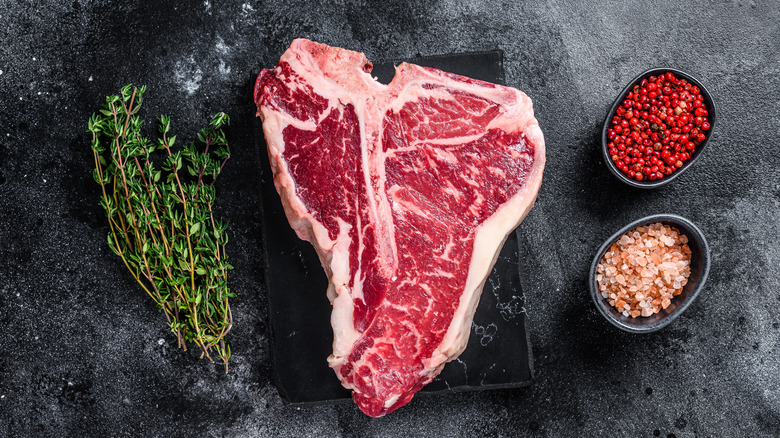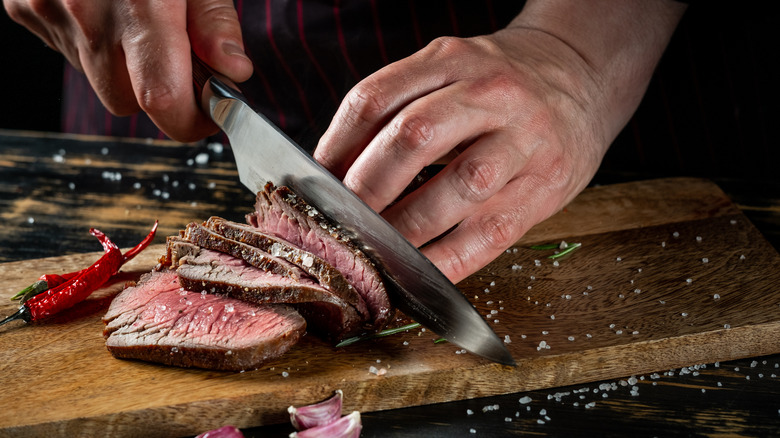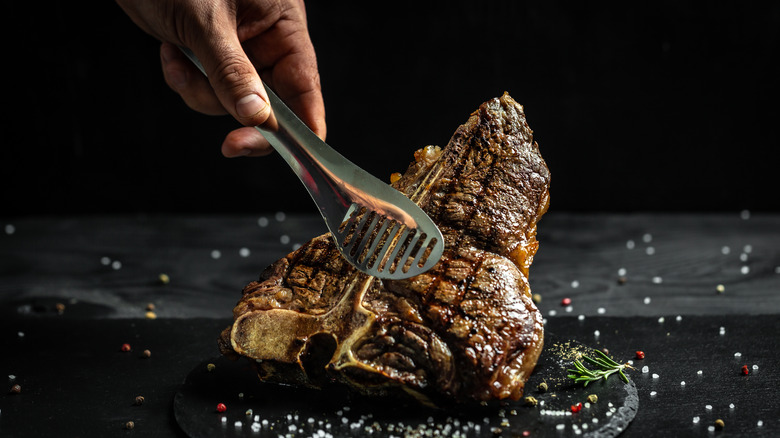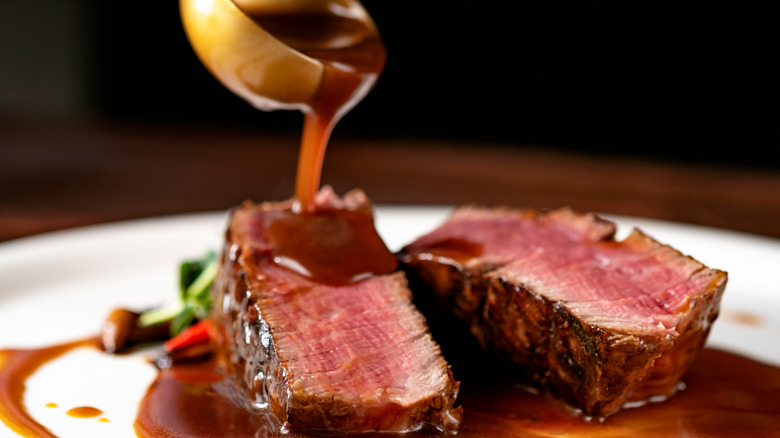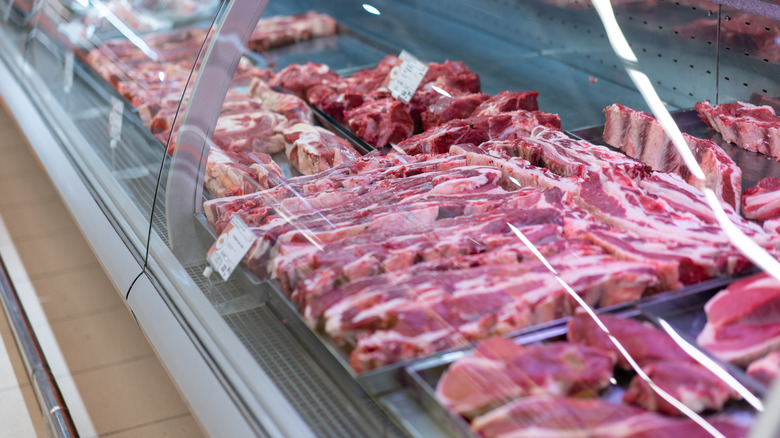Everything You Need To Know About Porterhouse Steak
Is there anything better than a juicy, well-seared steak that's seasoned to perfection and just waiting to be enjoyed in all its beefy goodness? Probably not. True steak lovers may not discriminate when it comes to cuts such as sirloin, flat iron, or classic T-bone, but that doesn't mean they don't sometimes get confused as to which steak is which and, especially, about how to cook these different types of meat.
One steak we hear a lot about is the porterhouse, a cut of meat that is prized by steakhouses and often among the most expensive options these restaurants offer. That's because the sizeable variety is a "two-for-one" that includes both filet mignon and strip steak. Porterhouses look just like T-bone steaks, characterized by the T-shaped bone pointing down the middle of the flesh and dividing the filet mignon (also known as tenderloin) from the strip (top loin) (via Money Inc). The key difference is that a porterhouse is cut much thicker than a T-bone, meaning that it includes a larger portion of filet mignon and is a much bigger serving of meat overall, comfortably feeding two people.
What does porterhouse steak taste like?
As noted above, a porterhouse is truly two steaks in one, with the filet mignon, or tenderloin, on one side, and the strip steak, or top loin, on the other. That being the case, this steak is an excellent choice for diners looking for two flavors and textures in one meal. Let's take a look at how these two cuts taste.
Filet mignon is known for being among the most tender cuts of steak. That being said, because it's lower in fat, filet can dry out very easily. When cooked appropriately — more on that in a minute — filet is tender, with a mild beefy flavor that's a good choice for meat-eaters who steer clear of gamier flavors.
Strip steak is a more forgiving cut of meat, with a higher fat quantity that prevents the cut from drying out. More fat, of course, also means more flavor: Strip steaks boast a rich, full-bodied beefy taste, according to Ruth's Chris Steak House, and are also quite tender, since this part of the cow does not get much exercise or movement.
How to cook porterhouse steak
Cooking a porterhouse can be tricky because the properties of the two cuts included in the steak vary significantly. Filet mignon, known to be super tender, is a very lean cut of meat. Its lack of a ton of fat marbling (which, when melted, can help keep a steak juicy) means that it can quickly dry out if cooked too long. Strip steak, on the other hand, has quite a bit of intramuscular fat and a nice cap of fat around its exterior, which makes it less prone to dryness. Therefore, cooking a porterhouse is a balancing act of heating the strip steak to the right temperature while keeping the filet amply juicy.
Kansas City Steaks notes that grilling is the preferred way to cook a porterhouse and recommends searing the seasoned steak over the hot part of the grill, whether it's charcoal or gas, then moving it to the cooler part of the grill and allowing it to cook to a temperature of about 130 degrees Fahrenheit, about 14 minutes for a 1.5-inch-thick steak. You can also broil porterhouse steaks, flipping them once halfway, or pan-sear them in a screaming hot cast-iron pan. Whichever way you cook a porterhouse, be sure to lightly cover it with tin foil and let it rest for five minutes before carving the meat. Seasonings can be as simple as salt and butter, as such a luxurious cut of meat can stand on its own.
Porterhouse steak nutritional information
The nutritional information of a porterhouse steak depends on which part you eat, though the facts overall are quite similar. A typical 3-ounce serving from the filet mignon side contains 185 calories and a whopping 23 grams of protein (via Men's Health). It has 9 grams of fat — 4 grams saturated and 4 grams monounsaturated. It doesn't contain carbohydrates, sugar, or fiber. Filet mignon is high in niacin, which has been shown to regulate cholesterol levels (via WebMD); a serving size boasts 6.2 milligrams, or 31% of the suggested daily intake, says Men's Health.
Three ounces from the strip steak, on the other hand, contains 164 calories and 25 grams of protein, according to Men's Health. It has 7 grams of fat — about half saturated and half monounsaturated — and is also free of carbohydrates, sugar, and fiber. A serving contains 26% of the suggested daily intake of vitamin B6, which is necessary for key bodily functions such as transporting oxygen through the blood, reports WebMD. Both parts of the porterhouse are high in zinc and selenium.
Where to buy porterhouse steak
The first place to look for any cut of steak is at your local butcher shop. Ask the butcher for a porterhouse, making sure it's not a T-bone steak. A good porterhouse should be deep red and cut at least 1 inch thick, preferably 1 ½ inches, so that it won't dry out when you cook it. The strip side of the steak should also have a generous marbling of white, not yellow, fat. Some higher-end supermarket chains, such as Whole Foods, will occasionally carry porterhouse steaks. There are also a number of steakhouse chains that ship the steaks around the country, including Kansas City Steaks and Chicago Steak Company. Wherever you purchase it, expect to shell out big bucks for quality.
For best results, cook your porterhouse steak within two days of purchase. Otherwise, you can wrap the steak tightly in plastic wrap and freeze it for up to three months. But we highly doubt a porterhouse will ever make it to the freezer — this is a delicious piece of meat that you'll be tempted to sear the moment you see it.
